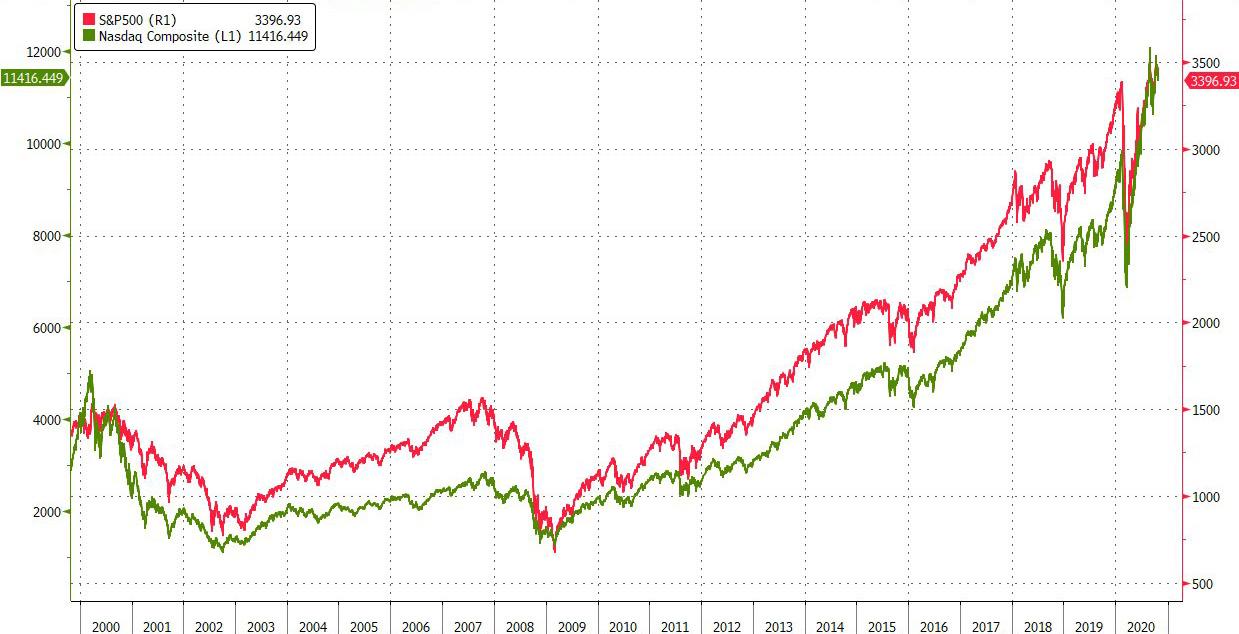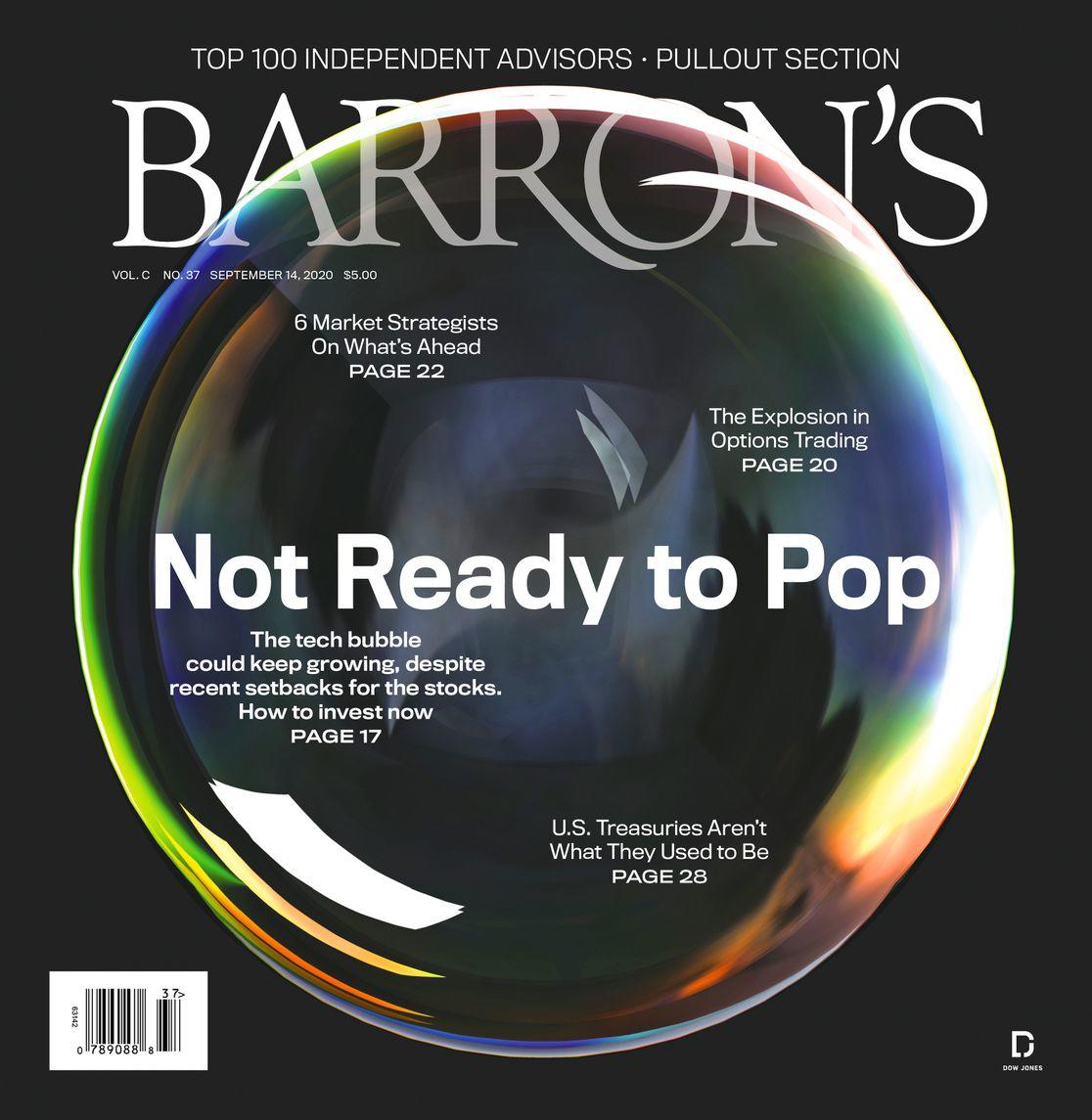September 2, September 2. There's something about that date.*
Lifted in toto from ZeroHedge, October 27:
For those who have not followed David Einhorn's crusade against central bank money printing, and the epic bubble these cluless academic hacks have created, his views on the "enormous tech bubble" we are currently living through and published in his latest letter to investors of his Greenlight hedge fund (which returned 5.9% in Q3) will provide some unique perspective.
To everyone else who is familiar with how his fund has been hammered by his tech short basket - and especially Tesla - over the past five years, as the most overvalued tech stocks in history continued to rip even higher year after year, we doubt his latest thoughts will come as a surprise, although his observations on the endgame are certainly remarkable, if for no other reason that he has dared to declare the time of death of said "enormous tech bubble" as Sept 2, 2020, the day the S&P500 and the Nasdaq both hit an all time high.
Why is Einhorn confident that this time he has finally timed the exact moment the bubble popped? He explains:
Bubbles tend to topple under their own weight. Everybody is in. The last short has covered. The last buyer has bought (or bought massive amounts of weekly calls). The decline starts and the psychology shifts from greed to complacency to worry to panic. Our working hypothesis, which might be disproven, is that September 2, 2020 was the top and the bubble has already popped. If so, investor sentiment is in the process of shifting from greed to complacency. We have adjusted our short book accordingly including adding a fresh bubble basket of mostly second-tier companies and recent IPOs trading at remarkable valuations
So without further ado, below we excerpt his key thoughts on the biggest asset bubble that the Fed has inflated:
* * *
We are now in the midst of an enormous tech bubble. We prematurely identified what we thought was a bubble in early 2016. Part of our thinking at the time was that the height of the 1999-2000 bubble was a once-in-a-career experience and that investors would not repeat that level of insanity. Clearly, we were mistaken.
Four years later, there is a consensus that we are in a bubble. Barron’s recently ran this on the cover:
All the signs of a bubble are there, including:
- an IPO mania;
- extraordinary valuations and new metrics for valuation;5
- a huge market concentration in a single sector and a few stocks;
- a second tier of stocks that most people haven’t heard of at S&P 500-type marketcapitalizations;
- the more fanciful and distant the narrative, it seems the better the stock performs;
- outperformance of companies suspected of fraud based on the consensus belief thatthere is no enforcement risk, without which crime pays;
- outsized reaction to economically irrelevant stock splits;
- increased participation of retail investors, who appear focused on the best-performing names;
- incredible trading volumes in speculative instruments like weekly call options andworthless common stock;6 and
- a parabolic ascent toward a top.
There are many anecdotes of toppy behavior. We will share one: We recently received a job application with the email subject, “I am young, but good at investments” from a 13-year-old who purports to have quadrupled his money since February.
Some analysts and commentators are comparing this bubble to the prior one. Have the valuations reached the prior insanity’s? Is the IPO mania just as large? Are the companies better today? Are they growing faster? Have the specific events that popped the last bubble happened? Are they likely to happen soon?
We believe these questions are a fool’s errand. The bubbles will never be exactly the same. In 2000, the Nasdaq peaked at 5,000. Why not 4,000? Why not 10,000? Or 20,000? Would there really have been a difference? If the Nasdaq had peaked at 3,500 instead of 5,000, the losses would have been 65% instead of 80%. Had it peaked at 3,500, it would be easier to argue that this bubble has surpassed that one. Had it peaked at 20,000, it would be easier to argue that there is still a long way to go. This analysis is arbitrary. Is a bubble only dangerous when it has exceeded the prior one on every metric?
What matters in a bubble is market psychology, not valuation. Valuation is irrelevant; that’s what makes it a bubble. Jeremy Grantham has done some of the best work on bubbles and by his criteria this one is a “Real McCoy.” The question at hand is where are we in the psychology of this bubble? On March 10, 2000, nobody knew that it was the top. Even by September 2000, it wasn’t clear. There was no obvious event that marked the top. Only in hindsight do people try to back fit an explanation.
Bubbles tend to topple under their own weight. Everybody is in. The last short has covered. The last buyer has bought (or bought massive amounts of weekly calls). The decline starts and the psychology shifts from greed to complacency to worry to panic. Our working hypothesis, which might be disproven, is that September 2, 2020 was the top and the bubble has already popped. If so, investor sentiment is in the process of shifting from greed to complacency. We have adjusted our short book accordingly including adding a fresh bubble basket of mostly second-tier companies and recent IPOs trading at remarkable valuations.
The post below was published with the S&P futures at 3,546.50 and the DJIA futures at 28,756.00. They were up pre-market but I've forgotten how much. By the end of the day the S&P 500 had set its all-time closing high of 3,588.11.
Writing "we are not there yet" it turns out we were 41 points (1.15%) away.
That is really lucky.
*September 2, 2020
[PDT]
Starting To Get Nervous About Equities
It would be nice to catch the exact top, to bookend March 20's "It's Time To Buy Some Stocks" but getting lucky twice in one move is a longshot. Here's a line from Warren Buffet in December 31, 2016's "A Quick Victory Lap (and some wisdom from Warren Buffett) NVDA":
...from his letter to shareholders, 1985:In January 2018 it was the Great Cobalt Trade of '17:
Our gain in net worth during the year was $613.6 million, or 48.2%. It is fitting that the visit of Halley’s Comet coincided with this percentage gain: neither will be seen again in my lifetime. Our gain in per-share book value over the last twenty- one years (that is, since present management took over) has been from $19.46 to $1643.71, or 23.2% compounded annually, another percentage that will not be repeated....And that's why we take the lap now, it won't happen again before Halley's big rock returns in 2062....
"In 2016 We Had the #1 Stock In the S&P 500, In 2017 We Had the Top-Performing Commodity, In 2018 We've Got.... "
Nuthin'.So, with the S&P futures at 3,546.50 and the DJIA futs at 28,756.00 I'm going to try to figure-out the timing and the next move and leave you with that "pretty good Warren Buffett story":
So here's a little victory dance 'til we figure something out.
And after that, a pretty good Warren Buffett story.....
....Which brings us to today when all I have to offer are a couple snips from Warren Buffett's Letters to the Shareholders of Berkshire Hathaway
The '85 Berkshire letter continues one of my favorite BRK stories.
First the background, from the 1984 Chairman's Letter:
"...Using my academic voice, I have told you in the past of the drag that a mushrooming capital base exerts upon rates of return. Unfortunately, my academic voice is now giving way to a reportorial voice. Our historical 22% rate is just that - history. To earn even 15% annually over the next decade (assuming we continue to follow our present dividend policy, about which more will be said later in this letter) we would need profits aggregating about $3.9 billion. Accomplishing this will require a few big ideas - small ones just won’t do. Charlie Munger, my partner in general management, and I do not have any such ideas at present, but our experience has been that they pop up occasionally. (How’s that for a strategic plan?)..."And then, the dénouement in the paragraph which immediately preceded the Halley's bit in the 1985 letter:
...You may remember the wildly upbeat message of last year’s report: nothing much was in the works but our experience had been that something big popped up occasionally. This carefully- crafted corporate strategy paid off in 1985. Later sections of this report discuss (a) our purchase of a major position in Capital Cities/ABC, (b) our acquisition of Scott & Fetzer, (c) our entry into a large, extended term participation in the insurance business of Fireman’s Fund, and (d) our sale of our stock in General Foods....
Earlier today:
Markets: What Changed On August 27?

